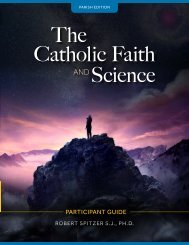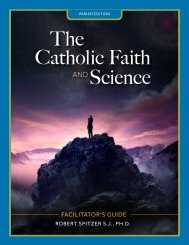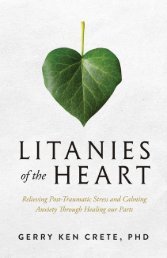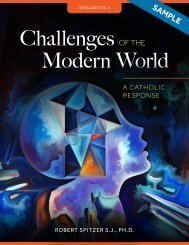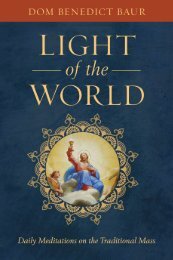- Page 3:
THE LIGHT of THE WORLD i
- Page 6 and 7:
BENEDICTUS BOOKS Copyright © 2022
- Page 8 and 9:
PART TWO THE EASTER CYCLE INTRODUCT
- Page 11 and 12:
PUBLISHER’S PREFACE Light of the
- Page 13 and 14:
Introduction “Arise, be enlighten
- Page 15 and 16:
Introduction through the Church. In
- Page 17 and 18:
PART ONE The Christmas Cycle 7
- Page 19 and 20:
The Christmas Cycle The liturgy of
- Page 21 and 22:
The Christmas Cycle Holy Eucharist
- Page 23 and 24:
The Christmas Cycle Monday “Knowi
- Page 25 and 26:
The Christmas Cycle Tuesday “To T
- Page 27 and 28:
The Christmas Cycle Scripture calls
- Page 29 and 30:
The Christmas Cycle complete trust
- Page 31 and 32:
The Christmas Cycle Saturday The st
- Page 33 and 34:
The Christmas Cycle already stands
- Page 35 and 36:
The Christmas Cycle “Behold the j
- Page 37 and 38:
The Christmas Cycle in the wilderne
- Page 39 and 40:
The Christmas Cycle more gloriously
- Page 41 and 42:
The Christmas Cycle people” (Anti
- Page 43 and 44:
The Christmas Cycle Prayer O God, w
- Page 45 and 46:
The Christmas Cycle In these refere
- Page 47 and 48:
The Christmas Cycle it cannot be th
- Page 49 and 50:
The Christmas Cycle who begot an un
- Page 51 and 52:
The Christmas Cycle Third Sunday of
- Page 53 and 54:
The Christmas Cycle “The Lord is
- Page 55 and 56:
The Christmas Cycle meet during thi
- Page 57 and 58:
The Christmas Cycle “Behold a vir
- Page 59 and 60:
The Christmas Cycle Ember Friday
- Page 61 and 62:
The Christmas Cycle night of sin an
- Page 63 and 64:
The Christmas Cycle “The Lord is
- Page 65 and 66:
The Christmas Cycle and sinfulness;
- Page 67 and 68:
The Christmas Cycle He enlightens u
- Page 69 and 70:
The Christmas Cycle banished God fr
- Page 71 and 72:
The Christmas Cycle throne, who doe
- Page 73 and 74:
The Christmas Cycle It is the Sun,
- Page 75 and 76:
The Christmas Cycle December 23, O
- Page 77 and 78:
The Christmas Cycle the Parousia at
- Page 79 and 80:
The Christmas Cycle We shall see Hi
- Page 81 and 82:
The Christmas Cycle the manger, and
- Page 83 and 84:
The Christmas Cycle the light, that
- Page 85 and 86:
The Christmas Cycle Him. In this is
- Page 87 and 88:
The Christmas Cycle and she shall e
- Page 89 and 90:
The Christmas Cycle however, now li
- Page 91 and 92:
The Christmas Cycle Sunday within t
- Page 93 and 94:
The Christmas Cycle voice” ( Jn 1
- Page 95 and 96:
The Christmas Cycle The Son of God
- Page 97 and 98:
The Christmas Cycle Our spiritual l
- Page 99 and 100:
The Christmas Cycle also hath exalt
- Page 101 and 102:
The Christmas Cycle Feast of the Ho
- Page 103 and 104:
The Christmas Cycle January 3, Octa
- Page 105 and 106:
The Christmas Cycle directs all thi
- Page 107 and 108:
The Christmas Cycle Vigil of Epipha
- Page 109 and 110:
The Christmas Cycle and mystical un
- Page 111 and 112:
The Christmas Cycle His feet by His
- Page 113 and 114:
The Christmas Cycle cross in Jerusa
- Page 115 and 116:
The Christmas Cycle subjecting our
- Page 117 and 118:
The Christmas Cycle O Lord Jesus Ch
- Page 119 and 120:
The Christmas Cycle With gifts in o
- Page 121 and 122:
The Christmas Cycle too, should do.
- Page 123 and 124:
The Christmas Cycle We believe in C
- Page 125 and 126:
The Christmas Cycle Old Testament;
- Page 127 and 128:
The Christmas Cycle people. Many of
- Page 129 and 130:
The Christmas Cycle Holy Ghost gave
- Page 131 and 132:
The Christmas Cycle one understandi
- Page 133 and 134:
The Christmas Cycle True Christiani
- Page 135 and 136:
The Christmas Cycle “The Lord hat
- Page 137 and 138:
The Christmas Cycle this acknowledg
- Page 139 and 140:
The Christmas Cycle Wednesday “Th
- Page 141 and 142:
The Christmas Cycle Today as we app
- Page 143 and 144:
The Christmas Cycle In Holy Communi
- Page 145 and 146:
The Christmas Cycle there, no malic
- Page 147 and 148:
The Christmas Cycle of the storm He
- Page 149 and 150:
The Christmas Cycle one’s neighbo
- Page 151 and 152:
The Christmas Cycle frailty. His da
- Page 153 and 154:
The Christmas Cycle Saturday “The
- Page 155 and 156:
The Christmas Cycle of the kingdom
- Page 157 and 158:
The Christmas Cycle into the field
- Page 159 and 160:
The Christmas Cycle In spite of the
- Page 161 and 162:
The Christmas Cycle determination t
- Page 163 and 164:
The Christmas Cycle “But while me
- Page 165 and 166:
The Christmas Cycle shorten the tim
- Page 167 and 168:
The Christmas Cycle Holy Communion.
- Page 169 and 170:
The Christmas Cycle even unto the d
- Page 171 and 172:
The Christmas Cycle not endure, but
- Page 173 and 174:
The Christmas Cycle and holiness of
- Page 175 and 176:
The Christmas Cycle St. John mentio
- Page 177 and 178:
The Christmas Cycle “to God from
- Page 179 and 180:
The Christmas Cycle the desert. “
- Page 181 and 182:
The Christmas Cycle sacred: his rel
- Page 183 and 184:
The Christmas Cycle We look at the
- Page 185 and 186:
The Christmas Cycle Prayer Have reg
- Page 187 and 188:
The Christmas Cycle time brings the
- Page 189 and 190:
The Christmas Cycle things at the c
- Page 191 and 192:
PART TWO The Easter Cycle 181
- Page 193 and 194:
The Easter Cycle of death surrounde
- Page 195 and 196:
The Easter Cycle wishes to accompli
- Page 197 and 198:
The Easter Cycle duties claims our
- Page 199 and 200:
The Easter Cycle enjoy the esteem o
- Page 201 and 202:
The Easter Cycle for all eternity.
- Page 203 and 204:
The Easter Cycle nature to the spir
- Page 205 and 206:
The Easter Cycle more frequently, i
- Page 207 and 208:
The Easter Cycle the earth; and all
- Page 209 and 210:
The Easter Cycle Prayer O God, who
- Page 211 and 212:
The Easter Cycle prospect of humili
- Page 213 and 214:
The Easter Cycle of prayer, or our
- Page 215 and 216:
The Easter Cycle Quinquagesima Sund
- Page 217 and 218:
The Easter Cycle the Holy Eucharist
- Page 219 and 220:
The Easter Cycle a deep earnestness
- Page 221 and 222:
The Easter Cycle A PECCATO MEO MUND
- Page 223 and 224:
The Easter Cycle merciful, patient
- Page 225 and 226:
The Easter Cycle under me soldiers;
- Page 227 and 228:
The Easter Cycle bowels from him; h
- Page 229 and 230:
The Easter Cycle First Sunday of Le
- Page 231 and 232:
The Easter Cycle During Lent we ret
- Page 233 and 234:
The Easter Cycle responsibility dur
- Page 235 and 236:
The Easter Cycle “I have put my t
- Page 237 and 238:
The Easter Cycle Thursday Today we
- Page 239 and 240:
The Easter Cycle ways and do penanc
- Page 241 and 242:
The Easter Cycle in the splendor of
- Page 243 and 244:
The Easter Cycle “At that time Je
- Page 245 and 246:
The Easter Cycle strong hand [throu
- Page 247 and 248:
The Easter Cycle The liturgy urges
- Page 249 and 250:
The Easter Cycle Him and to share H
- Page 251 and 252:
The Easter Cycle Friday Four weeks
- Page 253 and 254:
The Easter Cycle and in spite of ou
- Page 255 and 256:
The Easter Cycle not with Me is aga
- Page 257 and 258:
The Easter Cycle Prayer Have regard
- Page 259 and 260:
The Easter Cycle vessels were full
- Page 261 and 262:
The Easter Cycle essence of a good
- Page 263 and 264:
The Easter Cycle Friday We assemble
- Page 265 and 266:
The Easter Cycle During the days of
- Page 267 and 268:
The Easter Cycle city. But how shal
- Page 269 and 270:
The Easter Cycle Let us adhere to t
- Page 271 and 272:
The Easter Cycle Tuesday Lawrence,
- Page 273 and 274:
The Easter Cycle scrutiny successfu
- Page 275 and 276:
The Easter Cycle lifts itself up, a
- Page 277 and 278:
The Easter Cycle resurrection from
- Page 279 and 280:
The Easter Cycle Prayer Vouchsafe,
- Page 281 and 282:
The Easter Cycle The Introit shows
- Page 283 and 284:
The Easter Cycle “By His own bloo
- Page 285 and 286:
The Easter Cycle Prayer Sanctify ou
- Page 287 and 288:
The Easter Cycle His wishes. He com
- Page 289 and 290:
The Easter Cycle for Thy name’s s
- Page 291 and 292:
The Easter Cycle shall be martyrs;
- Page 293 and 294:
The Easter Cycle As she stands bene
- Page 295 and 296:
The Easter Cycle Prayer Let the peo
- Page 297 and 298:
The Easter Cycle “Thy creatures s
- Page 299 and 300:
The Easter Cycle for they know not
- Page 301 and 302:
The Easter Cycle of Man with a kiss
- Page 303 and 304:
The Easter Cycle undefiled in the w
- Page 305 and 306:
The Easter Cycle holy body. Men thu
- Page 307 and 308:
The Easter Cycle Prayer Almighty an
- Page 309 and 310:
The Easter Cycle As was her custom
- Page 311 and 312:
The Easter Cycle strength of our un
- Page 313 and 314:
The Easter Cycle In the liturgy St.
- Page 315 and 316:
The Easter Cycle CHRISTUS SURREXIT
- Page 317 and 318:
The Easter Cycle descended into the
- Page 319 and 320:
The Easter Cycle The lessons of Hol
- Page 321 and 322:
The Easter Cycle “This is the day
- Page 323 and 324:
The Easter Cycle is the kingdom of
- Page 325 and 326:
The Easter Cycle The former sinner,
- Page 327 and 328:
The Easter Cycle She cannot make ex
- Page 329 and 330:
The Easter Cycle is known as Alb Su
- Page 331 and 332:
The Easter Cycle come to us daily.
- Page 333 and 334:
The Easter Cycle the life of a man,
- Page 335 and 336:
The Easter Cycle have tasted that t
- Page 337 and 338:
The Easter Cycle them in the servic
- Page 339 and 340:
The Easter Cycle Saturday “Except
- Page 341 and 342:
The Easter Cycle Formerly it was th
- Page 343 and 344:
The Easter Cycle “I know Mine, an
- Page 345 and 346:
The Easter Cycle He knows and loves
- Page 347 and 348:
The Easter Cycle provider, and fath
- Page 349 and 350:
The Easter Cycle shall obtain the g
- Page 351 and 352:
The Easter Cycle virginal purity, b
- Page 353 and 354:
The Easter Cycle Now Christ speaks
- Page 355 and 356:
The Easter Cycle forehead, “yet a
- Page 357 and 358:
The Easter Cycle are commanded to b
- Page 359 and 360:
The Easter Cycle Thursday “Allelu
- Page 361 and 362:
The Easter Cycle This, then, is our
- Page 363 and 364:
The Easter Cycle mourn. . . . Bless
- Page 365 and 366:
The Easter Cycle and make them bear
- Page 367 and 368:
The Easter Cycle to His name; come
- Page 369 and 370:
The Easter Cycle Men of the world j
- Page 371 and 372:
The Easter Cycle and to maintain th
- Page 373 and 374:
The Easter Cycle gives beyond the m
- Page 375 and 376:
The Easter Cycle “Blessed are the
- Page 377 and 378:
The Easter Cycle heart of the Fathe
- Page 379 and 380:
The Easter Cycle from our enemies a
- Page 381 and 382:
The Easter Cycle God-fearing brothe
- Page 383 and 384:
The Easter Cycle brothers, share in
- Page 385 and 386:
The Easter Cycle back into Jerusale
- Page 387 and 388:
The Easter Cycle “He that shall h
- Page 389 and 390:
The Easter Cycle Sunday within the
- Page 391 and 392:
The Easter Cycle laymen, young men
- Page 393 and 394:
The Easter Cycle to become part of
- Page 395 and 396:
The Easter Cycle Wednesday within t
- Page 397 and 398:
The Easter Cycle Christ took immens
- Page 399 and 400:
The Easter Cycle sensible consolati
- Page 401 and 402:
The Easter Cycle martyrs. It gives
- Page 403 and 404:
The Easter Cycle Besides giving Him
- Page 405 and 406:
The Easter Cycle At the Offertory w
- Page 407 and 408:
The Easter Cycle And while Peter wa
- Page 409 and 410:
The Easter Cycle Jesus is the sheph
- Page 411 and 412:
The Easter Cycle touch of the Holy
- Page 413 and 414:
The Easter Cycle Holy Ghost within
- Page 415 and 416:
The Easter Cycle We have been recon
- Page 417 and 418:
PART THREE The Time After Pentecost
- Page 419 and 420:
The Time After Pentecost the grave
- Page 421 and 422:
The Time After Pentecost This is a
- Page 423 and 424:
The Time After Pentecost O Thou Mos
- Page 425 and 426:
The Time After Pentecost with one a
- Page 427 and 428:
The Time After Pentecost not merely
- Page 429 and 430:
The Time After Pentecost our lives
- Page 431 and 432:
The Time After Pentecost because He
- Page 433 and 434:
The Time After Pentecost “I will
- Page 435 and 436:
The Time After Pentecost Jesus is o
- Page 437 and 438:
The Time After Pentecost Prayer We
- Page 439 and 440:
The Time After Pentecost wax, both
- Page 441 and 442:
The Time After Pentecost cross of C
- Page 443 and 444:
The Time After Pentecost poverty of
- Page 445 and 446:
The Time After Pentecost or admit,
- Page 447 and 448:
The Time After Pentecost He “rece
- Page 449 and 450:
The Time After Pentecost love], we
- Page 451 and 452:
The Time After Pentecost God alone
- Page 453 and 454:
The Time After Pentecost Heart of J
- Page 455 and 456:
The Time After Pentecost and confid
- Page 457 and 458:
The Time After Pentecost exalt them
- Page 459 and 460:
The Time After Pentecost representa
- Page 461 and 462:
The Time After Pentecost Wednesday
- Page 463 and 464:
The Time After Pentecost to them of
- Page 465 and 466:
The Time After Pentecost the childr
- Page 467 and 468:
The Time After Pentecost with bitte
- Page 469 and 470:
The Time After Pentecost so-called
- Page 471 and 472:
The Time After Pentecost and by alw
- Page 473 and 474:
The Time After Pentecost our will;
- Page 475 and 476:
The Time After Pentecost Prayer O G
- Page 477 and 478:
The Time After Pentecost He had to
- Page 479 and 480:
The Time After Pentecost each other
- Page 481 and 482:
The Time After Pentecost us in bapt
- Page 483 and 484:
The Time After Pentecost During the
- Page 485 and 486:
The Time After Pentecost The death
- Page 487 and 488:
The Time After Pentecost of us do s
- Page 489 and 490:
The Time After Pentecost become ent
- Page 491 and 492:
The Time After Pentecost the servan
- Page 493 and 494:
The Time After Pentecost be on the
- Page 495 and 496:
The Time After Pentecost barren of
- Page 497 and 498:
The Time After Pentecost His intere
- Page 499 and 500:
The Time After Pentecost Prayer O G
- Page 501 and 502:
The Time After Pentecost opportunit
- Page 503 and 504:
The Time After Pentecost puts befor
- Page 505 and 506:
The Time After Pentecost guided in
- Page 507 and 508:
The Time After Pentecost head. Thus
- Page 509 and 510:
The Time After Pentecost “Suffer
- Page 511 and 512:
The Time After Pentecost of sonship
- Page 513 and 514:
The Time After Pentecost Spirit of
- Page 515 and 516:
The Time After Pentecost conquered
- Page 517 and 518:
The Time After Pentecost and thy ch
- Page 519 and 520:
The Time After Pentecost matter wha
- Page 521 and 522:
The Time After Pentecost “The day
- Page 523 and 524:
The Time After Pentecost things can
- Page 525 and 526:
The Time After Pentecost sickness,
- Page 527 and 528:
The Time After Pentecost received i
- Page 529 and 530:
The Time After Pentecost whose tale
- Page 531 and 532:
The Time After Pentecost Wednesday
- Page 533 and 534:
The Time After Pentecost (Introit).
- Page 535 and 536:
The Time After Pentecost Saturday
- Page 537 and 538:
The Time After Pentecost “Brethre
- Page 539 and 540:
The Time After Pentecost of the wor
- Page 541 and 542:
The Time After Pentecost was the la
- Page 543 and 544:
The Time After Pentecost life, keep
- Page 545 and 546:
The Time After Pentecost hath not b
- Page 547 and 548:
The Time After Pentecost also. “M
- Page 549 and 550:
The Time After Pentecost the priest
- Page 551 and 552:
The Time After Pentecost He leaves
- Page 553 and 554:
The Time After Pentecost of this br
- Page 555 and 556:
The Time After Pentecost the courag
- Page 557 and 558:
The Time After Pentecost justify hi
- Page 559 and 560:
The Time After Pentecost “Go and
- Page 561 and 562:
The Time After Pentecost And where
- Page 563 and 564: The Time After Pentecost Redeemer.
- Page 565 and 566: The Time After Pentecost God gives
- Page 567 and 568: The Time After Pentecost The spirit
- Page 569 and 570: The Time After Pentecost Prayer Alm
- Page 571 and 572: The Time After Pentecost God; and t
- Page 573 and 574: The Time After Pentecost first the
- Page 575 and 576: The Time After Pentecost the things
- Page 577 and 578: The Time After Pentecost Even indif
- Page 579 and 580: The Time After Pentecost Communion
- Page 581 and 582: The Time After Pentecost Adam’s s
- Page 583 and 584: The Time After Pentecost that we lo
- Page 585 and 586: The Time After Pentecost the Christ
- Page 587 and 588: The Time After Pentecost that we be
- Page 589 and 590: The Time After Pentecost whose fait
- Page 591 and 592: The Time After Pentecost has his di
- Page 593 and 594: The Time After Pentecost we offer t
- Page 595 and 596: The Time After Pentecost from our o
- Page 597 and 598: The Time After Pentecost the proud
- Page 599 and 600: The Time After Pentecost Tuesday Th
- Page 601 and 602: The Time After Pentecost see Him li
- Page 603 and 604: The Time After Pentecost Friday May
- Page 605 and 606: The Time After Pentecost without wh
- Page 607 and 608: The Time After Pentecost Meditation
- Page 609 and 610: The Time After Pentecost may be mer
- Page 611 and 612: The Time After Pentecost is the sac
- Page 613: The Time After Pentecost God penetr
- Page 617 and 618: The Time After Pentecost Eighteenth
- Page 619 and 620: The Time After Pentecost forgiven t
- Page 621 and 622: The Time After Pentecost First prov
- Page 623 and 624: The Time After Pentecost “Nothing
- Page 625 and 626: The Time After Pentecost Even the l
- Page 627 and 628: The Time After Pentecost of soul, a
- Page 629 and 630: The Time After Pentecost “The kin
- Page 631 and 632: The Time After Pentecost “I am th
- Page 633 and 634: The Time After Pentecost own way, d
- Page 635 and 636: The Time After Pentecost “Be angr
- Page 637 and 638: The Time After Pentecost in the Mas
- Page 639 and 640: The Time After Pentecost and suffer
- Page 641 and 642: The Time After Pentecost down befor
- Page 643 and 644: The Time After Pentecost last came
- Page 645 and 646: The Time After Pentecost and danger
- Page 647 and 648: The Time After Pentecost commands a
- Page 649 and 650: The Time After Pentecost Filled wit
- Page 651 and 652: The Time After Pentecost The hostil
- Page 653 and 654: The Time After Pentecost hast made
- Page 655 and 656: The Time After Pentecost In the Off
- Page 657 and 658: The Time After Pentecost then God f
- Page 659 and 660: The Time After Pentecost Him we owe
- Page 661 and 662: The Time After Pentecost salvation
- Page 663 and 664: The Time After Pentecost gave us in
- Page 665 and 666:
The Time After Pentecost “Behold
- Page 667 and 668:
The Time After Pentecost and in Com
- Page 669 and 670:
The Time After Pentecost Prayer O G
- Page 671 and 672:
The Time After Pentecost all, only
- Page 673 and 674:
The Time After Pentecost Charity gi
- Page 675 and 676:
The Time After Pentecost pray, beli
- Page 677 and 678:
The Time After Pentecost put forth,
- Page 679 and 680:
The Time After Pentecost our resurr
- Page 681 and 682:
The Time After Pentecost After havi
- Page 683 and 684:
The Time After Pentecost Him. We sh
- Page 685 and 686:
The Time After Pentecost shattering
- Page 687 and 688:
The Time After Pentecost have been
- Page 689 and 690:
The Time After Pentecost How much p
- Page 691 and 692:
The Time After Pentecost “The day
- Page 693 and 694:
The Time After Pentecost Thes 2:8).
- Page 695 and 696:
The Time After Pentecost the city,
- Page 697 and 698:
The Time After Pentecost toward one
- Page 699 and 700:
The Time After Pentecost Now I know
- Page 701 and 702:
The Time After Pentecost from an ev
- Page 703 and 704:
The Time After Pentecost For He rec
- Page 705 and 706:
The Time After Pentecost thy ear; f
- Page 707 and 708:
The Time After Pentecost His whole
- Page 709 and 710:
The Time After Pentecost “Sorrowf
- Page 711 and 712:
The Time After Pentecost Together w
- Page 713 and 714:
The Time After Pentecost sitteth up
- Page 715 and 716:
The Time After Pentecost this day a
- Page 717 and 718:
The Time After Pentecost “A hymn,
- Page 719 and 720:
The Time After Pentecost the poor s
- Page 721 and 722:
The Time After Pentecost The Dedica
- Page 723:
The Time After Pentecost of stone.
- Page 726 and 727:
The Light of the World Christmastid
- Page 728 and 729:
The Light of the World Life, supern
- Page 730:
The Light of the World Thomas, St.



